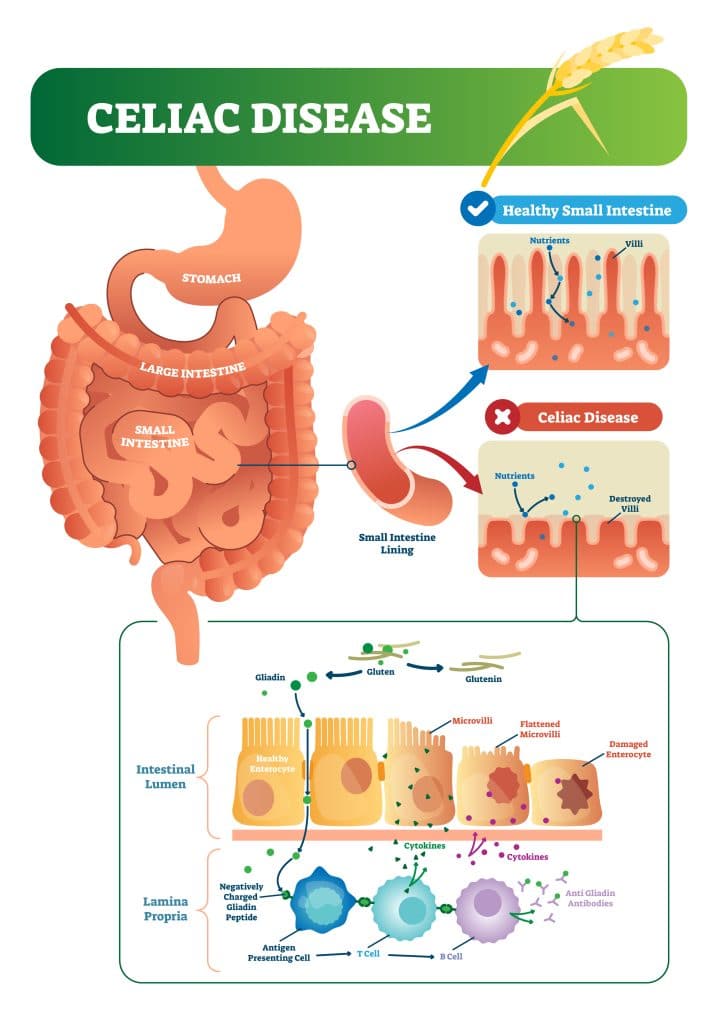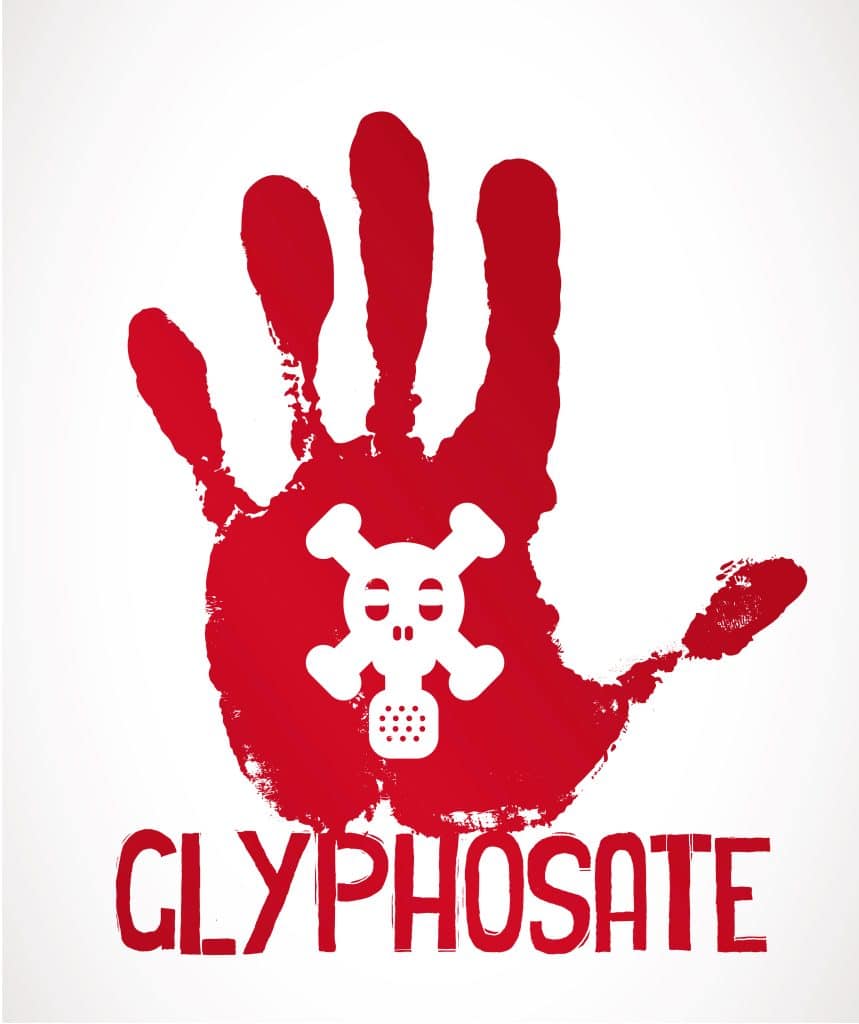What Causes Celiac Disease – The Connection Between Gluten, Genetics, Antibiotics, POPs, And Glyphosate
If you want to know what causes celiac disease, the answer is simple, it’s an autoimmune disorder that is triggered by ingesting gluten. However, the cause of gluten sensitivity is a bit more complex, as you will soon see. Gluten is a protein found in wheat, rye, and barley that can harm the small intestine of people with celiac disease. When someone with celiac disease eats even a small amount of gluten, their body reacts by damaging the villi, the tiny finger-like projections in the small intestine, which prevents the absorption of food and nutrients.1
Symptoms of celiac disease include chronic diarrhea, abdominal pain, weight loss, anemia, fatigue, bloating, and gas. These symptoms can vary from person to person. Some people with celiac may experience only mild discomfort while others may have severe reactions. It’s important to note that celiac disease can affect people of any age, including children, although it is more commonly diagnosed in adults.
Over the last five decades, there has been a dramatic increase in cases of celiac disease. In the United States alone, it is estimated that approximately 1 in 133 people suffer from this autoimmune disorder, with roughly 3 million Americans having been diagnosed with it.2
Treatment for celiac disease involves following a strict gluten-free diet, avoiding any foods that contain even trace amounts of gluten. This includes wheat, barley, rye, and oats. Other grains including corn and rice can be consumed safely as long as they are certified gluten-free.
What Causes Celiac Disease – Autoimmune Conditions
Celiac disease is an autoimmune condition. The body’s immune system mistakenly attacks itself, in this case targeting the lining of the small intestine, when exposed to gluten. This damages the villi resulting in the inability to absorb the nutrients from their food as effectively, leading to malnourishment and other health problems.3
What Causes Celiac Disease – Autoimmune Conditions And The Three-Legged Stool
Celiac disease, like all other autoimmune conditions, is the result of three different factors that I have named the three-legged stool. The legs of the stool are stressors, microbiome health, and DNA methylation.
What Causes Celiac Disease – Genetic Factors
Celiac disease often runs in families, suggesting a hereditary component. However, simply having the genetic disposition for developing celiac disease doesn’t necessarily mean that you will get it.
Genetics is complicated and even more complicated when considering epigenetics. In short, epigenetic methylation determines which genes are turned on and off. With adequate methyl groups to dictate epigenetic methylation, coding for undesirable phenotypes like celiac disease may be turned off.4
One leg of the three-legged stool is DNA methylation. Methylation is a process by which our genes are turned “on” or “off.” When methylation is not functioning properly, it can further contribute to immune system dysfunction and increased risk of autoimmune conditions.5
Methylation has been linked to a number of health maladies, including disease risk and aging. One example, the agouti gene, may be turned on or off depending on epigenetic methylation. When there aren’t enough methyl groups, the agouti gene expresses itself, leading to an obese and unhealthy mouse that in turn produces obese offspring as well.6
What Causes Celiac Disease – Environmental Factors
Another leg of the three-legged stool is environmental factors like toxins. Environmental factors and certain foods can act as triggers for celiac disease. Gluten is the major trigger. When people with celiac disease consume gluten, it causes their bodies to mount an immune response leading to small intestine damage. However, there are a number of stressors that contribute to developing celiac.

What Causes Celiac Disease – Toxins
People with celiac disease are often exposed to toxins, allergens, and other substances that trigger an autoimmune response. These can include antibiotics, hormones, food additives and preservatives, as well as chemicals like persistent organic pollutants and glyphosate.
This is why in addition to avoiding gluten-containing foods, people with celiac disease should also take steps to reduce their exposure to environmental toxins, allergens, and other substances that may trigger an autoimmune response.
What Causes Celiac Disease – Antibiotics
Recent research has suggested that antibiotic use is linked to an increased risk of developing celiac disease.7
Studies have demonstrated that antibiotics can alter the composition of bacteria in the digestive system, resulting in a decrease in beneficial bacteria and an increase in harmful ones. This can lead to increased permeability of the intestinal lining, allowing larger-than-normal amounts of gluten proteins to enter the bloodstream. This autoimmune reaction can trigger celiac disease.8
In addition, antibiotics can also affect vitamin D levels, which is a crucial vitamin for digestive health and the development of a healthy immune system. Low levels of vitamin D have been associated with an increased risk of celiac disease.9
178 Chemicals Associated With Developing Celiac Disease
Recent research has shown that 178 chemicals are associated with developing celiac disease, including some trace metals, food additives, persistent organic pollutants, and glyphosate.10
Certain food additives and preservatives can trigger an adverse reaction in those with celiac disease, so it is important to check labels for any potentially problematic ingredients.
Pesticides have also been linked to an increased risk of developing celiac disease. Exposure to these chemicals can be avoided by buying organic produce and avoiding contact with pesticide-treated areas. By understanding the chemicals associated with celiac disease, individuals can better manage their condition and reduce their risk of serious complications.

What Causes Celiac Disease – Food Additives And Preservatives
Food additives and preservatives are another trigger for celiac disease. Additives and preservatives are chemicals that are added to foods or beverages to extend shelf life and improve flavor, texture, or color. Many of these substances contain gluten, which may be overlooked as an ingredient on labels. Therefore, people with celiac disease must carefully read product labels and avoid foods containing additives and preservatives.11
Common food additives and preservatives that may contain gluten include malt, hydrolyzed vegetable protein (HVP), modified food starch, and monosodium glutamate (MSG). These chemicals are found in many processed foods including cereals, bread, condiments, sauces, margarine, and even candy. Avoiding these products is essential for people with celiac disease as even trace amounts of gluten can cause symptoms.
What Causes Celiac Disease – Persistent Organic Pollutants (POPs)
Persistent organic pollutants (POPs) like dichlorodiphenyldichlorethylenes, perflouoroalkyls, and polybrominated diphenyl ethers, are a group of chemical compounds that have been linked to celiac disease and the onset of autoimmune disorders. POPs can be found in everyday items like plastic, food packaging, pesticides, flame retardants, and other products. They can also enter the body through air pollution or contaminated water.
Studies suggest that people who are exposed to higher levels of these chemicals may be at a greater risk of developing celiac disease. Additionally, some research has shown that people with celiac disease have a higher level of these chemicals in their blood compared to those without the condition.12
What Causes Celiac Disease – Glyphosate
Glyphosate has been linked to the development of celiac disease. Glyphosate is a broad-spectrum herbicide used to kill weeds and grasses that compete with crops for nutrients and water. It is the major component of Roundup, a popular weed killer used by many home gardeners and commercial farmers.
Recent studies have linked glyphosate to the development of celiac disease. In one study, researchers found that rats exposed to glyphosate had significantly higher levels of antibodies associated with celiac disease compared to control animals. The researchers also observed changes in the structure of the intestine that are similar to those seen in people with celiac disease.
Celiac disease is associated with impairments in the cytochrome P450 enzymes responsible for detoxifying environmental toxins, activating vitamin D3, catabolizing vitamin A, and maintaining both bile acid production and sulfate supplies to the gut.
This impairment of the cytochrome P450 enzymes is likely caused by glyphosate, as this herbicide is known to inhibit the same enzymes. Furthermore, glyphosate has a strong ability to chelate certain elements like iron, cobalt, molybdenum, and copper. Coincidentally, deficiencies in these minerals are commonly associated with celiac disease.
Glyphosate is known to deplete certain essential amino acids such as tryptophan, tyrosine, methionine, and selenomethionine. A lack of these amino acids has also been linked to celiac disease. Finally, glyphosate exposure may be a contributing factor to increasing rates of non-Hodgkin’s lymphoma in individuals with celiac disease.13

Microbiome Health
Another leg of the three-legged stool is microbiome health. A healthy gut microbiome is key for warding off autoimmune conditions. Having a diverse and plentiful array of beneficial bacteria in the gut helps to reprogram our immune system to distinguish between self-antigens and foreign invaders. When this bacterial ecosystem is compromised, autoimmune disease often occurs.
What Causes Celiac Disease At The Core?
By addressing all three legs of the stool, stressors, microbiome health, and DNA methylation, we can effectively reduce our risk of developing autoimmune diseases like celiac disease. Exactly what causes celiac disease comes down to genetic factors and toxins like persistent organic pollutants, glyphosate, antibiotics, and other chemicals that manipulate microbiome function.
Read more about the core cause of autoimmune conditions.
References
1 Celiac Disease. (2023). Johns Hopkins Medicine. https://www.hopkinsmedicine.org/health/conditions-and-diseases/celiac-disease
2 Al-Toma, A., Volta, U., Auricchio, R., Castillejo, G., Sanders, D. S., Cellier, C., Mulder, C. J., & Lundin, K. E. A. (2019). European Society for the Study of Coeliac Disease (ESsCD) guideline for coeliac disease and other gluten-related disorders. United European gastroenterology journal, 7(5), 583–613. https://doi.org/10.1177/2050640619844125
3 Caio, G., Volta, U., Sapone, A. et al. Celiac disease: a comprehensive current review. BMC Med 17, 142 (2019). https://doi.org/10.1186/s12916-019-1380-z
4 Gnodi, E., Meneveri, R., & Barisani, D. (2022). Celiac disease: From genetics to epigenetics. World journal of gastroenterology, 28(4), 449–463. https://doi.org/10.3748/wjg.v28.i4.449
5 Quintero-Ronderos, P., & Montoya-Ortiz, G. (2012). Epigenetics and autoimmune diseases. Autoimmune diseases, 2012, 593720. https://doi.org/10.1155/2012/593720
6 Neuroepic. (2022, June). BPA: Not A-gouti Thing for You –. https://neuroepic.mcdb.lsa.umich.edu/wp/14-bpa-not-a-gouti-thing-for-you/
7 Jiang, H. Y., Zhang, X., Zhou, Y. Y., Jiang, C. M., & Shi, Y. D. (2020). Infection, antibiotic exposure, and risk of celiac disease: A systematic review and meta-analysis. Journal of gastroenterology and hepatology, 35(4), 557–566. https://doi.org/10.1111/jgh.14928
8 Olshan, K. L., Leonard, M. M., Serena, G., Zomorrodi, A. R., & Fasano, A. (2020). Gut microbiota in Celiac Disease: microbes, metabolites, pathways and therapeutics. Expert review of clinical immunology, 16(11), 1075–1092. https://doi.org/10.1080/1744666X.2021.1840354
9 Vici, G., Camilletti, D., & Polzonetti, V. (2020). Possible Role of Vitamin D in Celiac Disease Onset. Nutrients, 12(4), 1051. https://doi.org/10.3390/nu12041051
10 Lu, M., Feng, R., Liu, Y., Qin, Y., Deng, H., Xiao, Y., & Yin, C. (2022). Identifying celiac disease-related chemicals by transcriptome-wide association study and chemical-gene interaction analyses. Frontiers in genetics, 13, 990483. https://doi.org/10.3389/fgene.2022.990483
11 Mancuso, C., & Barisani, D. (2019). Food additives can act as triggering factors in celiac disease: Current knowledge based on a critical review of the literature. World journal of clinical cases, 7(8), 917–927. https://doi.org/10.12998/wjcc.v7.i8.917
12 Abigail Gaylord, Leonardo Trasande, Kurunthachalam Kannan, Kristen M. Thomas, Sunmi Lee, Mengling Liu, Jeremiah Levine, Persistent organic pollutant exposure and celiac disease: A pilot study, Environmental Research, Volume 186, 2020, 109439, ISSN 0013-9351, https://doi.org/10.1016/j.envres.2020.109439.
13 Samsel, A., & Seneff, S. (2013). Glyphosate, pathways to modern diseases II: Celiac sprue and gluten intolerance. Interdisciplinary toxicology, 6(4), 159–184. https://doi.org/10.2478/intox-2013-0026









